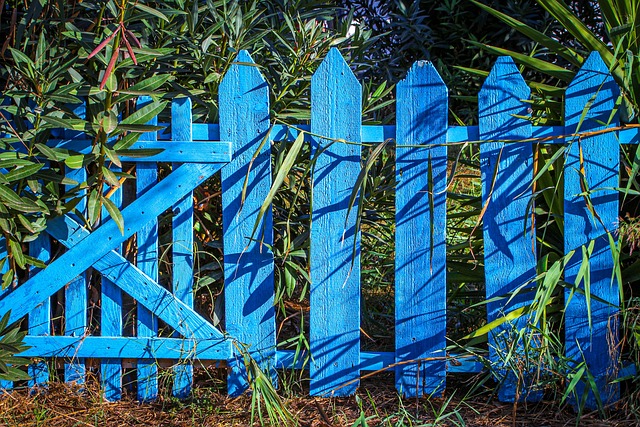Introduction
Fences serve not only as structural elements but also as aesthetic additions to your property. Fence staining and sealing are essential practices to maintain their beauty and longevity, protecting them from the harsh effects of weather and UV rays. This comprehensive guide delves into the intricacies of fence staining, from understanding its benefits and exploring various types to mastering preparation, color choices, sealing techniques, maintenance tips, and even considering DIY versus professional services. By the end, you’ll be equipped to transform your wooden fence into a vibrant, protected feature on your property.
- Understanding Fence Staining: Benefits and Types
- Preparing Your Wooden Fence for Staining
- Choosing the Right Stain: Color Options & Factors
- The Sealing Process: Protection Against Elements
- Maintenance Tips for Long-Lasting Results
- DIY vs. Hiring a Professional Stainer
Understanding Fence Staining: Benefits and Types
Fence staining is a popular method to enhance the aesthetics and protect wooden fences. It involves applying a colored sealant to the fence’s surface, which can transform an ordinary fence into a stunning feature of your outdoor space. The process offers various benefits beyond simple cosmetic improvements. Firstly, it shields the wood from harsh weather conditions, including UV rays, rain, and snow, preventing fading, cracking, and rot. This protection is crucial for maintaining the fence’s structural integrity and longevity.
There are several types of fence staining options available. Water-based stains are popular for their low odor and quick drying time. They provide a subtle color boost and are often environmentally friendly. Semi-transparent or transparent stains offer better protection while still allowing some natural wood grain to show, creating a more subtle aesthetic appeal. Solid color stains, on the other hand, provide complete coverage and can transform the fence into any desired shade, offering maximum customization for personal preferences.
Preparing Your Wooden Fence for Staining
Before applying any stain or sealer to your wooden fence, proper preparation is key. Start by thoroughly cleaning the fence to remove any dirt, dust, and debris that might hinder the staining process. Use a pressure washer or a stiff-bristled brush with mild detergent and water to ensure a clean surface. This step is crucial as it allows the stain to adhere better to the wood.
Once cleaned, inspect your fence for any damaged or rotten sections. Repair or replace these areas to maintain the structural integrity of the fence. Fill in any gaps or cracks with a suitable filler, and sand the surface gently to create a smooth base. This preparation ensures that your fence not only looks its best but also lasts longer after staining.
Choosing the Right Stain: Color Options & Factors
When choosing a fence stain, color options are abundant and can be tailored to suit any aesthetic preference or the desired ambiance for your outdoor space. Traditional shades include browns, tans, and greens, offering earthy tones that complement natural settings. Bolder colors like reds, blues, and blacks provide a more dramatic effect, adding personality to your fence. Dark stains enhance grain patterns, while lighter ones can make wooden fences appear larger and brighter.
Several factors should guide your decision. Consider the type of wood on your fence—some stains are formulated for specific types to ensure optimal adhesion and longevity. Weather conditions in your area play a significant role; harsh climates may require water-repellent or UV-resistant stains that can withstand exposure. The overall maintenance level you’re comfortable with is also crucial, as some stains offer longer-lasting protection but might need more frequent reapplication compared to others.
The Sealing Process: Protection Against Elements
The sealing process is an essential step after staining your wooden fence, as it provides an extra layer of protection against the elements. Sealing acts as a barrier, shielding the wood from harmful UV rays, intense rain, and damaging frost. By applying a high-quality sealer, you create a protective coat that prevents moisture penetration, which can cause rot and weaken the fence over time.
This process involves careful application of the sealer, ensuring even coverage for optimal results. Sealers come in various types, offering different levels of durability and protection. A good sealant will not only enhance the aesthetic appeal of your fence but also extend its lifespan, keeping it looking fresh and new for years to come.
Maintenance Tips for Long-Lasting Results
Regular maintenance is key to ensuring your fence stays looking its best and prolongs the life of the stain. Start by cleaning the fence annually to remove any built-up dirt, mold, or mildew using a pressure washer or a mild detergent solution. This step is crucial as it prepares the surface for reapplication of the stain.
After cleaning, inspect the fence for any damaged or loose boards and repair as needed. Re-stain every 2–3 years, depending on exposure to elements, to maintain protection against fading and cracking. Always follow the manufacturer’s instructions for proper application techniques, and consider sealing after staining to create an extra layer of defense against water damage and UV rays.
DIY vs. Hiring a Professional Stainer
When it comes to fence staining and sealing, the choice between doing it yourself (DIY) or hiring a professional stainer is an important one. DIY enthusiasts often see this project as an opportunity to unleash their creativity and save some money. With the right tools and a well-planned schedule, they can achieve a fresh look for their wooden fences. However, staining requires careful preparation and application techniques to ensure longevity and aesthetics. If you’re new to such projects or lack the time, it’s advisable to consider professional services.
Hiring a seasoned stainer offers several benefits. Professionals have the expertise to handle intricate details and achieve a flawless finish. They possess the necessary equipment and supplies, ensuring a more efficient and consistent job. Moreover, professionals can provide expert advice on the best stains and sealing products tailored to your fence’s specific needs, taking into account factors like climate and wood type. This ensures better durability and longevity of the stain.
